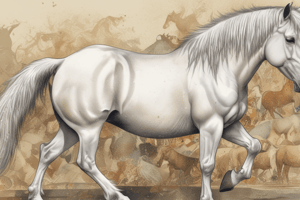Podcast
Questions and Answers
What is the primary characteristic of Streptococcus equi, the causative agent of Strangles?
What is the primary characteristic of Streptococcus equi, the causative agent of Strangles?
- It is a Gram-negative, B-hemolytic, Lancefield group C coccus.
- It is a Gram-positive, capsulated, B-hemolytic, Lancefield group C coccus. (correct)
- It is a Gram-negative, non-capsulated, B-hemolytic, Lancefield group A coccus.
- It is a Gram-positive, non-capsulated, B-hemolytic, Lancefield group B coccus.
What is the primary source of infection for Strangles?
What is the primary source of infection for Strangles?
- Vectors such as flies and mosquitoes.
- Contaminated feed and hay.
- Direct contact with infectious exudates and fomites. (correct)
- Contaminated water sources.
What is the incubation period for Strangles?
What is the incubation period for Strangles?
- 3 to 14 days (correct)
- 7 to 21 days
- 1 to 7 days
- 14 to 28 days
What is a characteristic of horses with involvement of the retropharyngeal lymph nodes?
What is a characteristic of horses with involvement of the retropharyngeal lymph nodes?
What is the most common cause of brain abscess in horses?
What is the most common cause of brain abscess in horses?
What is the primary method of diagnosis for Strangles?
What is the primary method of diagnosis for Strangles?
What is the duration of survival of Streptococcus equi outside of the host under favorable conditions?
What is the duration of survival of Streptococcus equi outside of the host under favorable conditions?
What is the clinical presentation of horses with residual immunity to Strangles?
What is the clinical presentation of horses with residual immunity to Strangles?
What is the primary route of infection for Rhodococcus equi in foals?
What is the primary route of infection for Rhodococcus equi in foals?
What is a common complication of treatment with erythromycin and rifampin in foals?
What is a common complication of treatment with erythromycin and rifampin in foals?
What is the mechanism of action of Rhodococcus equi in host cells?
What is the mechanism of action of Rhodococcus equi in host cells?
What is the purpose of administering hyperimmuned plasma in foals?
What is the purpose of administering hyperimmuned plasma in foals?
What is a common clinical sign of Lyme disease in animals?
What is a common clinical sign of Lyme disease in animals?
What is the minimum duration of tick attachment required for transmission of Borrelia burgdorferi?
What is the minimum duration of tick attachment required for transmission of Borrelia burgdorferi?
What is a common intestinal manifestation of Rhodococcus equi infection in foals?
What is a common intestinal manifestation of Rhodococcus equi infection in foals?
What is an alternative to erythromycin and rifampin for the treatment of Rhodococcus equi infection in foals?
What is an alternative to erythromycin and rifampin for the treatment of Rhodococcus equi infection in foals?
What is the breed of horse that is genetically predisposed to recurrent uveitis?
What is the breed of horse that is genetically predisposed to recurrent uveitis?
What is the serovar of Leptospira that is responsible for most abortions in horses?
What is the serovar of Leptospira that is responsible for most abortions in horses?
What is the duration of shedding of Leptospira organisms in urine by aborting mares?
What is the duration of shedding of Leptospira organisms in urine by aborting mares?
What is the characteristic of Leptospira-induced acute renal failure in horses?
What is the characteristic of Leptospira-induced acute renal failure in horses?
What is the treatment of choice for Leptospira infection in horses?
What is the treatment of choice for Leptospira infection in horses?
What is the common clinical presentation of horses with Leptospira infection?
What is the common clinical presentation of horses with Leptospira infection?
What is the primary mechanism of prevention of Leptospira infection in horses?
What is the primary mechanism of prevention of Leptospira infection in horses?
What is the common complication of Leptospira-induced abortion in horses?
What is the common complication of Leptospira-induced abortion in horses?
What is the primary treatment for horses with Salmonella enterica subspp_Enterica serotype infections?
What is the primary treatment for horses with Salmonella enterica subspp_Enterica serotype infections?
Which of the following is a clinical sign of Salmonella enterica subspp_Enterica serotype infections in horses?
Which of the following is a clinical sign of Salmonella enterica subspp_Enterica serotype infections in horses?
What is the purpose of temporarily closing and emptying wards in the prevention of nosocomial infections in horse facilities?
What is the purpose of temporarily closing and emptying wards in the prevention of nosocomial infections in horse facilities?
Which of the following antimicrobials is not used in the treatment of systemic infections in horses?
Which of the following antimicrobials is not used in the treatment of systemic infections in horses?
What is the primary method of detecting Salmonella enterica subspp_Enterica serotype infections in horses?
What is the primary method of detecting Salmonella enterica subspp_Enterica serotype infections in horses?
What is the mortality rate of tetanus in horses?
What is the mortality rate of tetanus in horses?
Which of the following is a method of preventing Salmonella enterica subspp_Enterica serotype infections in horses?
Which of the following is a method of preventing Salmonella enterica subspp_Enterica serotype infections in horses?
What is the primary mechanism of action of botulinum toxin?
What is the primary mechanism of action of botulinum toxin?
What is the risk associated with Salmonella enterica subspp_Enterica serotype infections in horses?
What is the risk associated with Salmonella enterica subspp_Enterica serotype infections in horses?
What is the recommended treatment for horses with tetanus in the early stages of disease?
What is the recommended treatment for horses with tetanus in the early stages of disease?
Which of the following is not a type of Salmonella enterica subspp_Enterica serotype infection in horses?
Which of the following is not a type of Salmonella enterica subspp_Enterica serotype infection in horses?
What is the recommended vaccination schedule for foals at high risk?
What is the recommended vaccination schedule for foals at high risk?
What is the typical clinical sign of botulism in foals?
What is the typical clinical sign of botulism in foals?
What is the primary source of Clostridium botulinum?
What is the primary source of Clostridium botulinum?
What is the recommended dose of tetanus antitoxin for non-immunized horses?
What is the recommended dose of tetanus antitoxin for non-immunized horses?
What is the typical clinical sign of tetanus in adult horses?
What is the typical clinical sign of tetanus in adult horses?
Flashcards are hidden until you start studying
Study Notes
Bacterial Diseases in Horses
Strangles (Distemper)
- Caused by Streptococcus equi, a Gram-positive, capsulated, beta-hemolytic, Lancefield group C coccus
- Highly contagious and host-adapted, affecting only horses, donkeys, and mules
- Pathogenesis: transmission via fomites and direct contact with infectious exudates, carrier animals are an important source of infection
- Organism is susceptible to desiccation, extreme heat, and exposure to sunlight
- Clinical findings:
- Incubation period: 3-14 days
- Fever: 39.4-41.1°C
- Mucoid to mucopurulent nasal discharge
- Depression
- Submandibular lymphadenopathy
- Difficulty in swallowing, inspiratory respiratory noise, and extended head and neck in horses with retropharyngeal lymph node involvement
- Metastatic Strangles (Bastard Strangles): characterized by abscessation in other lymph nodes, particularly in the abdomen and less frequently in the thorax
Diagnosis and Treatment
- Diagnosis: bacterial culture of exudates from abscesses and nasal swab samples, CBC, endoscopic examination of the upper respiratory tract, and ultrasonography of the retropharyngeal area
- Treatment: systemic administration of antimicrobials, fluid therapy, corticosteroid and cyclosporine for temporary relief, and vitrectomy with gentamycin lavage
Prevention
- Isolation of acutely infected horses for 14-16 weeks
- Detection of urine by FAT
- Limiting exposure to stagnant water and potential maintenance hosts
- Vaccination
Salmonella and Nosocomial Infection
- Caused by Salmonella enterica subspp. Enterica serotype Typhimurium, Newport, Anatum, and Agona
- Clinical signs:
- Enterocolitis
- Diarrhea
- Fever
- Leukopenia
- Treatment: antimicrobial treatment
- Prevention:
- Cleaning and disinfecting of horse facilities
- Temporarily closing and emptying wards, and instituting thorough and intensive cleaning and disinfecting procedures
- Strict traffic of humans and animals
- Adequate ventilation and distance between cases
Tetanus
- Caused by Clostridium tetani
- Clinical signs:
- Fever
- Muscle stiffness
- Hyperesthesia
- Opisthotonus
- Respiratory failure
- Diagnosis:
- Clinical signs and history of recent trauma
- Demonstration of toxin in serum of affected animal
- Anaerobic culture and demonstration of bacteria from wound
- Treatment and control:
- Curariform agents, tranquilizers, or barbiturate sedatives in conjunction with tetanus antitoxin
- Administration of tetanus antitoxin into the subarachnoid space
- Draining and cleaning of wounds, and administering penicillin or broad-spectrum antibiotics
- Placing in a quiet, darkened stall box with feeding and watering devices
- Sling for horses with difficulty in standing or rising
- Prevention:
- Active immunization with tetanus toxoid
- Wound management and immunization
- Yearly toxoid booster
- Vaccination of mares during the last week of pregnancy
- Vaccination of foals at 5-8 weeks of age
Botulism
- Caused by toxins produced by Clostridium botulinum
- Botulinum toxin acts on the peripheral nervous system by preventing transmission of nervous impulses
- Found in soil and decaying plant or animal matter
- Adult horses and foals less than 8 months old affected
- Clinical signs:
- Foals: impaired suckling, inability to swallow, decreased eyelid and tail tone, dilated pupils, and respiratory paralysis
- Adults: parenteral nutrition
- Treatment: supportive care and antitoxin administration
Suppurative Bronchopneumonia
- Caused by Rhodococcus equi in foals
- Also causes ulcerative enterocolitis, colonic-mesenteric lymphadenopathy, immune-mediated synovitis and uveitis, osteomyelitis, pyogranulomatous dermatitis, brain abscess, immune-mediated anemia, and septic arthritis
- Inhalation of contaminated dust is the most important route for pneumonic infection in foals
- Facultative intracellular parasites of monocytes and macrophages
- Clinical signs:
- Suppurative bronchopneumonia with extensive abscess formation and suppurative lymphadenitis
- Early signs: slight increase in respiratory rate and mild fever
- More commonly: acute respiratory distress and high fever
- Intestinal manifestations: granulomatous or suppurative inflammation of Peyer's patches and mesenteric or colonic lymph nodes
- Treatment: administration of erythromycin and rifampin, or azithromycin and clarithromycin in combination with rifampin
- Prevention:
- Husbandry: stocking density, proper ventilation, and dust control
- Passive immunity: transfusion of hyperimmuned plasma
- Chemoprophylaxis: development of superinfections, bacterial resistance, and antimicrobial-induced colitis
Lyme Disease
- Caused by Borrelia burgdorferi
- 2-year enzootic dual infection with Anaplasma phagocytophilum cycle involving Ixodes ticks and mammals
- Ticks must be attached to a mammal for at least 24 hours
- Clinical signs:
- Low-grade fever
- Stiffness and lameness in more than one limb
- Muscle tenderness, hyperesthesia, and swollen joints
- Lethargy and behavioral changes
- Treatment:
- Tetracycline
- Doxycycline
- Ceftiofur
- Prevention:
- Preventing tick exposure or prolonged attachment
- Early antimicrobial treatment after exposure
- Vaccination
Leptospirosis
- Caused by highly invasive Leptospira
- Clinical syndrome:
- Reproductive tract: Leptospira interrogans serovar Pomona, responsible for most Leptospira abortions
- Acute renal failure: Leptospira Pomona, causing severe and acute renal failure
- Recurrent uveitis: Leptospira interrogans serovar Pomona, causing immune-mediated keratitis and recurrent uveitis
- Treatment:
- Tetracycline
- Doxycycline
- Prevention:
- Preventing exposure to contaminated urine and water
- Vaccination
Studying That Suits You
Use AI to generate personalized quizzes and flashcards to suit your learning preferences.



